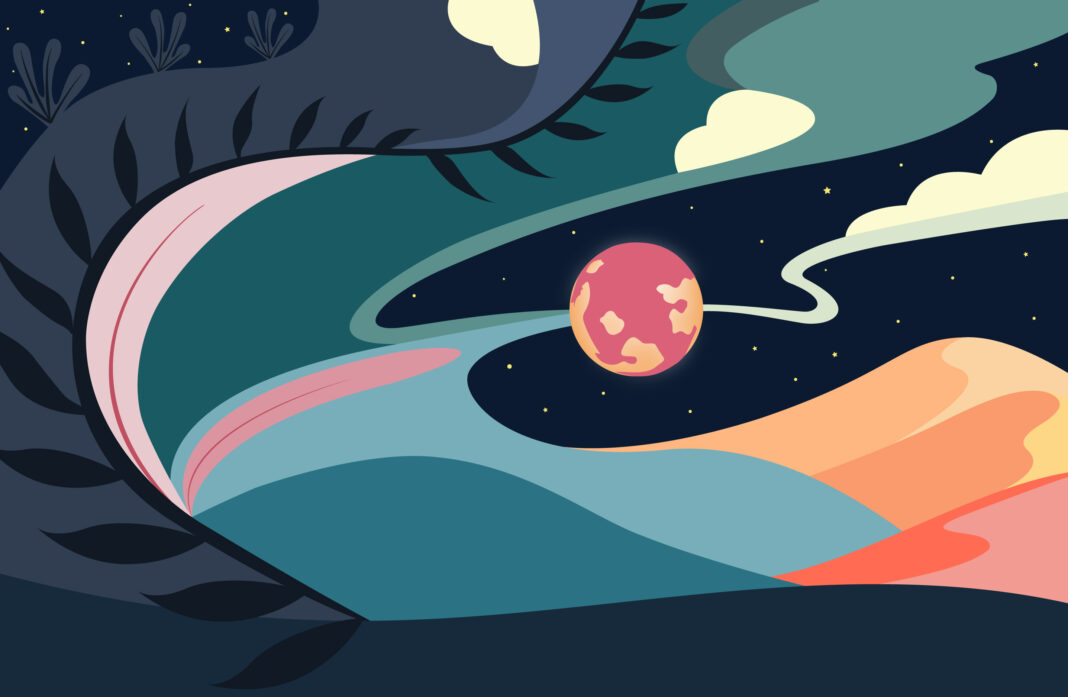What is the origin of life? How do simple molecules combine to create self-replicating life forms? Does life exist elsewhere in the universe? Undoubtedly, those are the most fundamental questions of humankind. But how do we even know what to look for? What is a life sign? Will we know life when we see it?
Of course, the first smart attempt is to search for life as we know it. Many reasons support this idea. Life on Earth is made out of the most abundant elements in the universe: hydrogen, oxygen, carbon, nitrogen, etc. Carbon is a very versatile atom, able to bond with many other elements and produce all sorts of molecule sizes and shapes, from the simplest to very large molecules like hemoglobin or DNA.
Many regions in outer space have huge clouds of gas and dust mixed with material coming from supernovae. Astronomers have detected water, essential for life on Earth, and many organic molecules in those clouds, from carbon monoxide or carbon dioxide to macromolecules as big as about seventy carbon atoms or fullerenes. The stars and their planets are formed in those regions, and many exoplanets end up having a lot of organic and water molecules.
But the question of life, of course, goes beyond searching for elements and molecules. For that reason, astrobiologists search for biosignatures. A biosignature is an object, a substance, or a pattern whose origin requires a biological process.
The list goes from bio-organic molecules, structures with cellular morphologies, certain atmospheric gasses to sedimentary rocks with patterns such as tracks or fecal pellets suspected produced by organisms. For most of these biosignatures to be considered, they should be abundant, characteristic of some form of an ecosystem, and highly improbable of nonbiological origin.
Defining biosignatures is still a heated discussion. Many scientists agree that the question of life elsewhere in the universe should be as broad as possible. For that reason, in 2018, the NASA astrobiology department assigned a $7 million grant to the Laboratory for Agnostic Biosignatures, a team searching for extraterrestrial life as we don’t know it on Earth.
Agnostic biosignatures are those untied to any characteristic component of life as we know it, such as particular elements or molecules. An agnostic biosignature can, instead, emerge from unexpected complexity in a system that could be an entire environment or a whole planet.
Investigating planetary complexity, not composition
In an article published yesterday in Nature Astronomy, Stuart Bartlett and collaborators propose that assessing the complexity and randomness of the physical processes occurring in an exoplanet could be used as an indicator of life. Their idea is to use information theory to characterize exoplanets potentially hosting a biosphere by considering an alternative to the traditional concept of biosignature. “We cannot ignore the strong possibility that alien life may be chemically and materially different from life as we know it, and this has led some researchers to consider alternative and agnostic biosignatures,” they wrote.
What is complexity? We have been very successful in describing the behavior of many systems by understanding the physics of their elements. For example, we can model an electrical circuit—very precisely—just by looking at the resistors, capacitors, and wires connecting them no matter how complicated they seem.
In a complex system, by contrast, the interactions and relationships between its components, and the system with its environment, make it extremely hard to describe. Living organisms, a planet’s climate, or social and economic organizations are examples of complex systems that cannot be fully understood by looking at their components.
The association between complexity and the emergence of life is clear. The researchers use a computational technique to calculate the complexity of a planet using observational data organized in time. They argue that their methods can be used to compare planets. Increasing complexity values with time may reveal increasing planetary complexity.
They also investigate the Shannon entropy rate, which quantifies “the degree of randomness in the process, or the rate at which ‘surprise’ is generated.” Increasing complexity and Shannon entropy mean the planet is rich in its dynamical process: it is far from a dead rock and probably has interesting geology and atmospheric dynamics.
The authors explain:
“By extension from the association between life and complexity, we can propose the following hypothesis: those planets exhibiting greatest complexity will have the highest likelihood of fostering their own biospheres.
For example, imagine that oxygen is detected in a planetary atmosphere and the discovery is claimed to be indicative of a biosphere. If the planet exhibits a low complexity and low entropy, we might question whether the oxygen is from an abiotic source, or a byproduct of a geochemical process, since life is distinguished not just by what it produces or is made from, but by what it does.
Conversely, an observed exoplanet might exhibit no spectral or chemical features associated with life as we know it but may show a high complexity. In this case, the planet might be worthy of further study because the high complexity would suggest a high computational capacity and physical richness.”
Life as we don’t know it, but complexity as we know it
When scientists propose a novel framework, the first step is to test it in well-known systems. Stuart Bartlett and collaborators used their method to investigate and compare the Earth with Jupiter. They used surface and atmospheric data from the National Oceanic and Atmospheric Administration (NOAA) Earth Observation Satellite Deep Space Climate Observatory to assess Earth’s complexity and Shannon entropy. For Jupiter, they used data from the NASA-Cassini mission.
They found that the Earth is 50% more complex and has a 43% higher entropy rate than Jupiter on average. The authors argued that, although the Earth’s most complex features come from abiotic structures: clouds and surfaces, for example, it is clear they are “strongly and inextricably linked to the biosphere.”
“It seems highly unlikely that the removal or absence of life would leave the main abiotic features of Earth trivially unchanged. It seems more likely that the climate system, oceans, lithosphere, and matter cycles would adopt different compositions, dynamical regimes and appearance, given that the planet is not just the linear sum of its components.”
A whole planet as the living thing
The criteria for an agnostic biosignature proposed by Bartlett and collaborators consider life as planetary phenomena, “something that happens to a planet, not on a planet.” It does not mean they regard planets as living organisms, but that the biotic and abiotic sources coevolve indissoluble for life to succeed.
Although their studies are not conclusive and can not be taken as proof of their hypothesis, stating that complexity correlates with life, their methods seem to have great potential to compare exoplanets discriminating the one with more change to host a biosphere.
Proposing biosignatures for life as we don’t know it seems challenging; it crosses the frontier between science and philosophy, where the underlying question is: What is life?
References
Bartlett, S., Li, J., Gu, L., Sinapayen, L., Fan, S., Natraj, V., Jiang, J. H., Crisp, D., & Yung, Y. L. (2022). Assessing planetary complexity and potential agnostic biosignatures using epsilon machines. Nature Astronomy. https://doi.org/10.1038/s41550-021-01559-x
LAB | Laboratory for Agnostic Biosignatures. (2020). Laboratory for Agnostic Biosignatures. Retrieved February 8, 2022, from https://www.agnosticbiosignatures.org/
Can We Find Life? | The Search For Life –. (2020, December 15). Exoplanet Exploration: Planets Beyond Our Solar System. Retrieved February 8, 2022, from https://exoplanets.nasa.gov/search-for-life/can-we-find-life/
Kaufman, M. (2019, September 13). NASA Astrobiology. Astrobiology at NASA. Retrieved February 8, 2022, from https://astrobiology.nasa.gov/news/agnostic-biosignatures-and-the-path-to-life-as-we-dont-know-it/
Illustration by Dana Dumea.





